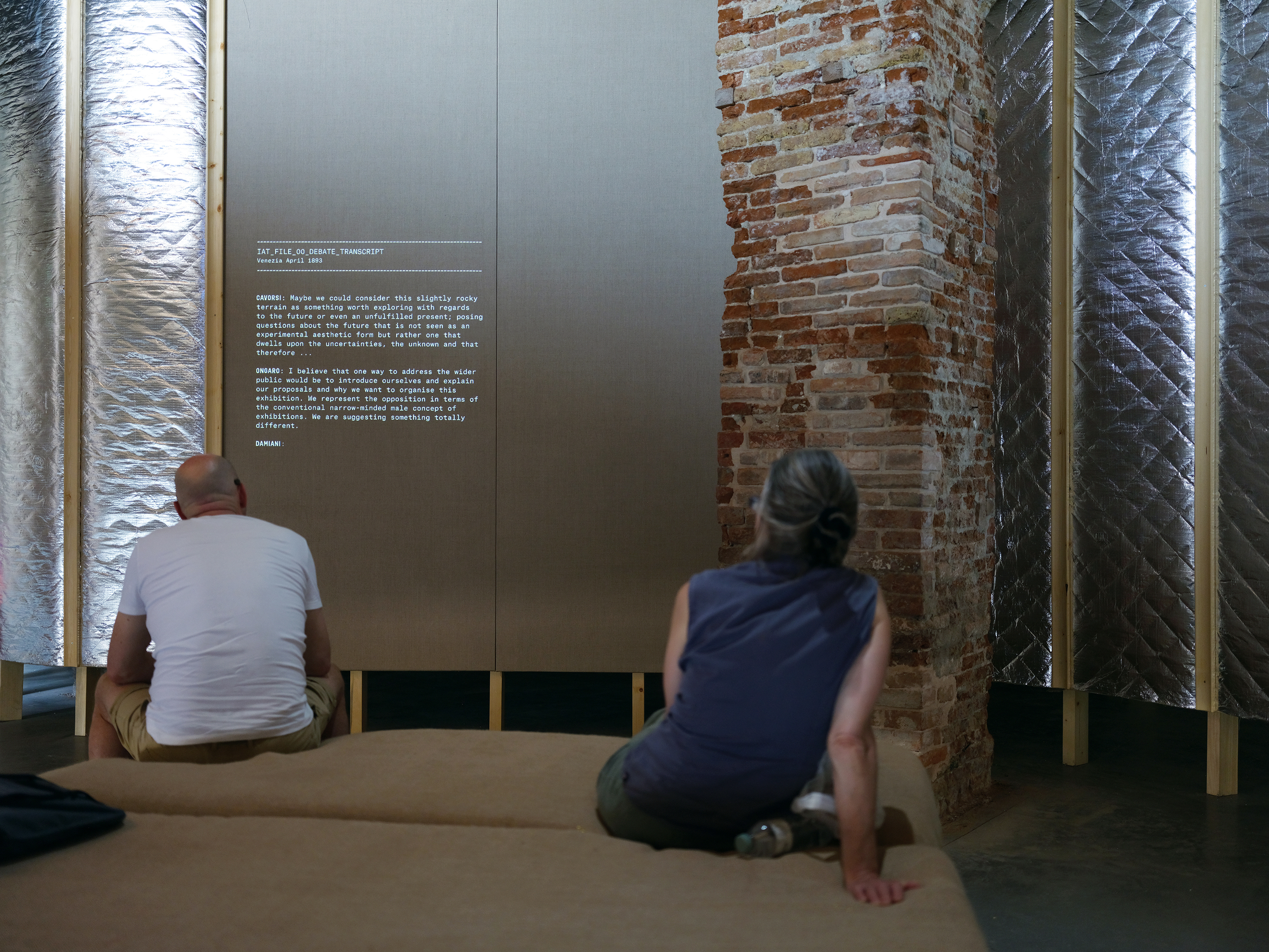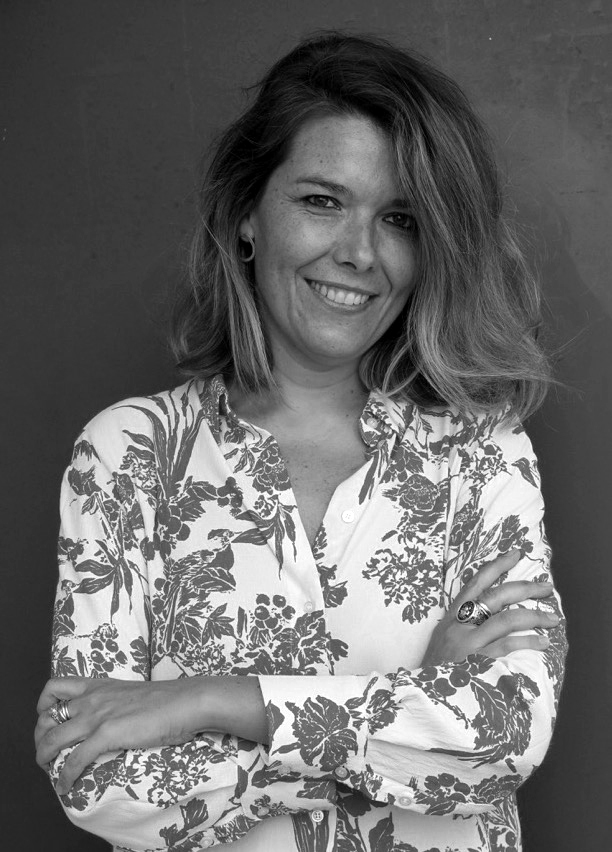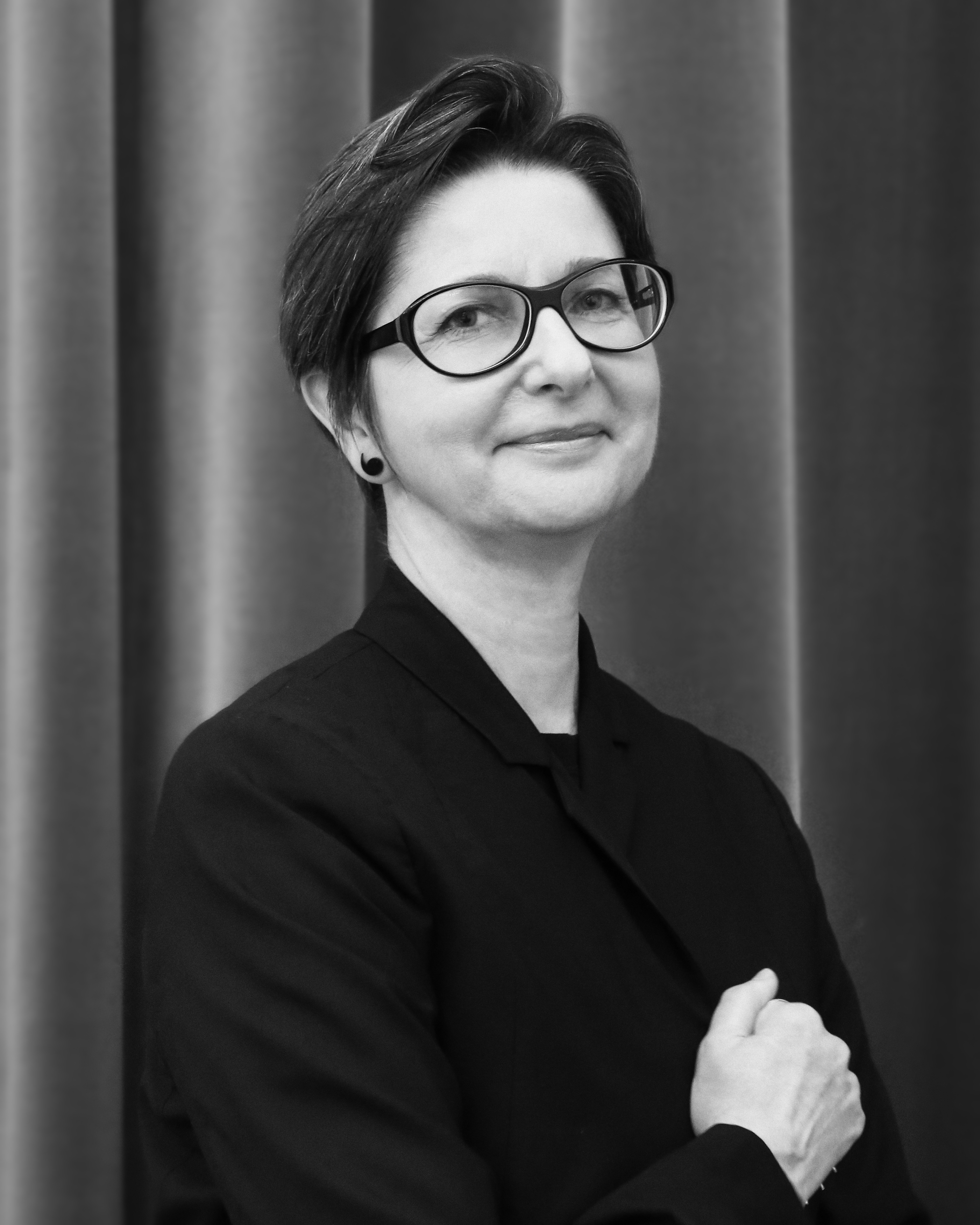“Era ora!”: Cristina Baldacci and Marysia Lewandowska discuss Lewandowska’s It’s About Time
Art historian Cristina Baldacci and artist Marysia Lewandowska discuss It’s About Time (translated into Italian as ‘Era ora!’), her Special Project in the Pavilion of Applied Arts (curated by Ralph Rugoff) for the 58th International Art Exhibition – La Biennale di Venezia. Based on records of meetings held by the Mayor of Venice (Riccardo Selvatico) between 1893 and 1895, the project focuses on the absence of women from art history, taking the Biennale as a case in point.
As part of her project, Lewandowska invited a group of Italian women practitioners(L. Cavorsi, G. Damiani, V. Facchin, A. Ongaro, C. Pierleoni, F. Pitrolo, C. Ricci, S. Tanzini, F. Tarocco. ) to re-imagine what La Biennale di Venezia would look like if women had been involved in its foundation. Through historical information, fiction, and critical awareness, the resulting debate among these women resounds within an immersive structure designed by Studio Abroad. The structure is shaped like a double enclave, where, on one side, a newly edited video based on footage from the V&A archive is shown, while on the other side we hear a sound recording of approximately 20 minutes in which Italian female voices are planning the very first edition of La Biennale. This is how the “unheard voices”, including Felicita Bevilacqua La Masa and other women who took part in the Venetian cultural life at the end of the 19th century, were recorded and inserted into the present time.

Marysia Lewandowska, It’s About Time, 58th Biennale di Venezia. Photo courtesy of Xavier Ribas.
CB: We met for our conversation nearby the Venetian Archivio di Stato: it can only be a good omen. Although you said you were not interested in archives, looking at your practice of the last thirty years, your work has repeatedly engaged with different aspects (mnemonic, political, cultural) related to them. You have been questioning the archive as an institution, a classification system, and a source of materials.(See, e.g., the two long-term projects Women’s Audio Archive, 1984-1990, and Enthusiasts Archive, 2004-2019 (with N. Cummings).) It’s About Time (2019), the project you developed for the Venice Biennale, begun with mining two distinct collections of historical documents – one of the Biennale itself and the other of the V&A Museum in London – and was expanded by visits to the City of Venice Archive and to Fondazione Bevilacqua La Masa. Are you sure you are not fascinated by archives?
ML: For many years now I have been exploring the question of value and artistic production. My work as an artist often directly addressed museums, which are considered institutions guaranteeing the cultural value of artefacts. However, what interests me most are the people, their social relations, and how institutions organize those relations into governance, which impacts our understanding of value and ourselves. The Biennale has emerged from particular political and economic circumstances involving many actors. Through research I set out to understand who was involved and why, in order to dismantle that knowledge, identifying silences that led me to producing new knowledge.
CB: Speaking of relationships, the one between knowledge and archive is particularly problematic. Postmodernism has shown that archives are never neutral spaces, that there is always someone behind them who creates hierarchies among documents, collecting, selecting and classifying them – often also by controlling access. The archive is undeniably an institution of power, and as such it must be constantly put into question both as a guarantor of knowledge and as historical truth. How do you address uncertainty of knowledge from within the archive itself?
ML: Rather than treating the archive as a place where accurate accounts can be found, I insist that its cumulative function must be augmented by fantasy as a strategy, enabling ‘unfixing’, opening the archive to multiple uses by multiple agents. By combining fiction with what can actually be found there, the authenticity of any given account is thrown into question. This allows for politics to play a significant part in the story. “Unfixing” can be problematic, too: if everything was in a state of flux, we couldn’t easily access the materials multiple times. The better the archive is organized, the more useful it becomes. Only then, undoing its organization to expose internal hierarchies and power structures can be performed.
CB: How do you position the space of the imagination in relation to factography?
ML: The written, photographic, audio-visual sources that I consulted for my Venice project all appear to have been touched by fiction; what I created was a new context for the women who were missing from the original narrative. In the process of my research, I became most concerned by their apparent absence from records of public life in late 19thcentury Venice.
CB: In order to re-imagine History and to introduce parallel or unfinished histories, addressing minorities, margins and missing events, you have to perform an archaeological task in the Foucauldian sense, for which anachronism, together with the imagination, are key tools.
ML: While writing the script for It’s About Time, together with those nine Italian feminists who later performed it as a live recording, what we collectively proposed was a form of embodied enquiry. We all had a connection to the narrated history and together experienced the consequences of that history. Through the act of collective writing we reflected on how an event such as the Venice Biennale touches our practices as women artists and intellectuals. The claim we make re-imagines the public space of the exhibition populated by a different kind of imagination and affect.
CB: From a feminist perspective, if one thinks of the near absence of women in the cultural system and in art history throughout the 19th and 20th centuries, what you propose can be seen as an act of self-historicization as well as of collective-consciousness exposed through your engagement with the archive. If the record of the conversation between Felicita Bevilacqua La Masa and other Venetian women discussing the need for an international art exhibition in Venice cannot be found in any of the city’s archives, it is because around 1895, when the Biennale was established, the time was not yet ripe. By inventing and producing such a record in 2019, you are filling that void in the social imaginary. You are enacting an absence to re-habilitate history. Can one say that you are shifting attention from the archive to its afterlife?
ML: My recording allows for a conceptual process to unfold in real time, perhaps. People who experience it and listen to it, inside a specially designed enclave, wonder if what they hear originated in the archive. They have to do the work of unravelling the anachronistic approach to the story. They hear a language that belongs to the 19th century confronted with radical contemporary ideas. The project settles on undoing time, and by producing an augmented history, it reminds us of a struggle to perform against the grain, against expectations – including the expectations of the archive itself. I refuse to fulfil the revelation of having found something, and instead I perform the revelation of absence. I direct my energy not so much towards disrupting but towards nourishing the archive. I’m nourishing the archive as much as the archive is nourishing me.

Marysia Lewandowska, It’s About Time, 58th Biennale di Venezia. Photo courtesy of Xavier Ribas.
CB: Nourishing is an interesting term because it’s related to the idea of taking care. Besides being a gesture of sensitivity towards the archive and towards history, taking care—a typically feminine action—is also an act of recollecting all those people and histories that could be easily forgotten, if there is a lack of use and of interest. The danger is silence, thus, oblivion.
ML: Every project creates a community of interest. People who are involved in developing it with you form a community with whom you trigger the process of searching and re-searching. And when the project is released into the public realm, there is a different community that gathers around it, that cares about it. That’s how art can produce communities and disseminate attention. You cannot take care of everyone and their histories, but you can insist on a certain unresolved part of your own history playing a part in that relationship.
CB: This is where politics and time become closely connected. What makes past events and people relevant, meaningful for the present and, thus, for the future? Why should we, as contemporaries, care and what should we care about?
ML: What caring introduces is connecting affectively with the past. I presented a trace of the live debate that took place in a recording studio, inviting the visitors to the Biennale into a space of sharing, where benefiting from a collective experience translates into empowerment. By calling upon the origins of the Biennale I am able to critically implicate its organisation and point to how its model, established over one hundred and twenty years ago, continues to reproduce itself, still without any governing presence of women. This creates an opportunity to reflect upon the specific circumstances, while pointing to a wider cultural context of discrimination.
CB: Is It’s About Time discussing the origins and possibilities of a past event – in this specific case, the foundation of La Biennale di Venezia – to be configured or re-enacted in the present under different conditions and along different lines?
ML: Yes, in order to succeed with this new proposal, I’m also recalling the dead. The figure of Felicita Bevilacqua La Masa has been brought to life through her own hand-written will, her testament, where she outlines her wishes for when she is no longer here. She literally shapes the future and obliges the city of Venice to fulfil her last wish. Could we also claim the archive as a form of testament, inviting us to action? In an act of faith the rules of memory and justice don’t necessarily follow the habitual progression of time, they can be swapped round. This produces an anachronism: Bevilacqua La Masa creates her will that others must respect and activate; I answer that call with a project that makes it possible for her voice to be heard.
CB: Besides being a testament in itself, does the archive also have a will?
ML: In the cast of female protagonists that I put together for the project, the archive is also a character looking for me to be its narrator, igniting a flirtatious relationship resulting in an unpredictable outcome. As with all flirts, we need to fall under its spell. What is behind this curious noun: “spell”? And how does it connect to spelling, one’s ability to correctly compose a word?
CB: I like very much the idea that the archive waits to be inquired into, to start a flirty conversation, as if it were both looking for you and looking at you, demanding something. This gives the archive a human trait. Even if it’s usually considered the space of bureaucracy—papers have their own objectivity–the archive collects testimonies that are waiting to be told. But these (silent) voices need a medium. You provided such a platform by inviting the visitor of the Pavilion of Applied Arts to participate in the process of mediation with her body.
ML: What I tried to produce by building co-joined enclaves designed by the architects Georges Massoud and Summer Islam inside the monumental spaces of the Sale d’Armi of the Arsenale is an intimate architecture for an immersive encounter with the Italian female voices. This helps the visitor to become aware of her own corporeality and temporality while the voice resonates in its sonic texture, accompanied by the simultaneous projection that translates the Italian text into English. That way the visitor may claim her time to rehearse whatever might be necessary to create her own sense of history, community, and presence.
CB: It’s more than that: as a visitor you are involved with your entire body and its senses. The double enclave environment stimulates an immersive experience for history to come alive (as female) again…
ML: By reading, speaking, showing and connecting what is essentially a mute past with the currency of experience – inside It’s About Time that currency is listening – the eyes become the ears. Whether it’s for a feminist cause, like in this case, or for other causes, these are the missing ingredients you need in order to then identify your own voice within a given history.
CB: If the archive becomes a site for activism, is its re-activation a means of emancipation?
ML: It’s About Time attempts to create a tension between what can be accessed – the public records in the archive – and what is privately desired. It represents not mere uncovering of what has always been there, but points towards what could have been by exploiting every possible route that such atemporal, anachronistic and blasphemous tension invites. The archive in this sense is a host that encounters a fate of a hostage to an/other kind of imaginary.
Articles in this special issue:
[su_menu name=”Venice Biennale”]






